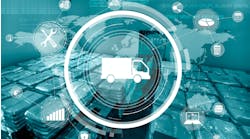How to create digital standards for a better shipping experience
By Bart De Muynck, chief industry officer, project44
In a manufacturing world that's evolving to be more global, more complex and more digital, there's an increasing need for digital standards for supply chains to effectively communicate. An estimated 90% of world trade is carried by container shipping, but manual, paper-based processes continue to dominate key transactions. Even in over-the-road transportation, paper bills of lading are still the standard. This limits information exchange and often hinders visibility into real-time data. As global trade continues to increase, there is a greater need for supply chains to be digitized and standardized. Historic precedents suggest digital standards are achievable, but will require collaboration across government agencies and supply-chain stakeholders.
The proliferation of data
Now, some of you might argue that there already are standards. Wasn’t EDI with Edifact and ANSI X12 a standard? Didn't we develop XML standards more than 20 years ago? I was personally involved with CIDX in the early 2000s to develop specific XML messages for the chemical industry. Yet for decades, a myriad of concerns have prevented us from sharing data: data siloing, lack of system and data interoperability, competitiveness concerns, legal issues, use of paper, lack of data protection, etc. Meanwhile, in logistics we have been able to standardize containers to 20ft and 40ft containers. We have been able to agree on barcodes and make those into standards.
So, it is possible.
In the past decade, we have seen the amount of data available grow 60-fold. We have seen the advent of super computers that can do up to 1 trillion computations per second to deal with this huge amount of data. And we have developed advanced artificial intelligence (AI) and machine learning (ML) techniques that can make sense out of the data and translate it into valuable insights. So, in short, we are in a perfect spot to collaborate globally to create digital standards for transportation to achieve data standardization across messaging formats as well as key transportation documents.
What it takes to create a standard
Before we can address the topic of digital standards, we need to discuss several components that are vital for the creation of any standard. Those components can be described as the data network, the data quality, the communication methods, and even the source of standards—whether it’s transactional messages like a tender, or document types such as bills of lading, certificates of origin, proof of delivery and many others.
When we talk about standards for any type of data, we need to first talk about the origins of the data, which is the network. In the case of transportation visibility, it's a network consisting of hundreds of thousands of transportation providers across multiple modes and a multitude of regions, each with its own peculiarities.
Each of those transportation providers has access to different data sets, ranging from data in their TMS, telematic, ERPs and other systems to data from sub-contractors. On top of that, they use different technologies through which they can communicate this data. Any platform that wants to centralize data and/or approach standardization needs to be able to speak the different languages and technologies (API, EDI, XML) in order to collect the data.
As a next step, it is vital that the platform has the intelligence to ensure the data quality is what it needs to be. That requires intelligence to collect, interpret, cleanse, normalize and augment data through advanced AI and ML capabilities. The more data the platform works with, the better the quality of those intelligent processes.
Looking ahead
While the volume and breadth of data can be overwhelming, it is a critical tool to improve visibility in the supply chain. Digital standards will remove barriers to collaboration—ultimately making supply-chain processes more efficient and enhancing the overall shipping experience.
It is a complex task to create a digital standard, but the reality is that it is an even bigger task to ensure everyone adopts the standard. It takes a collaborative approach, and it takes time. It will be important that supply chains work together, but also work with government agencies like the Federal Maritime Commission, Freight Logistics Optimization Works and others. I personally believe that shippers and manufacturers can move the ball forward through current data initiatives and by organizing conversations with their carriers and their supply-chain ecosystem partners.



